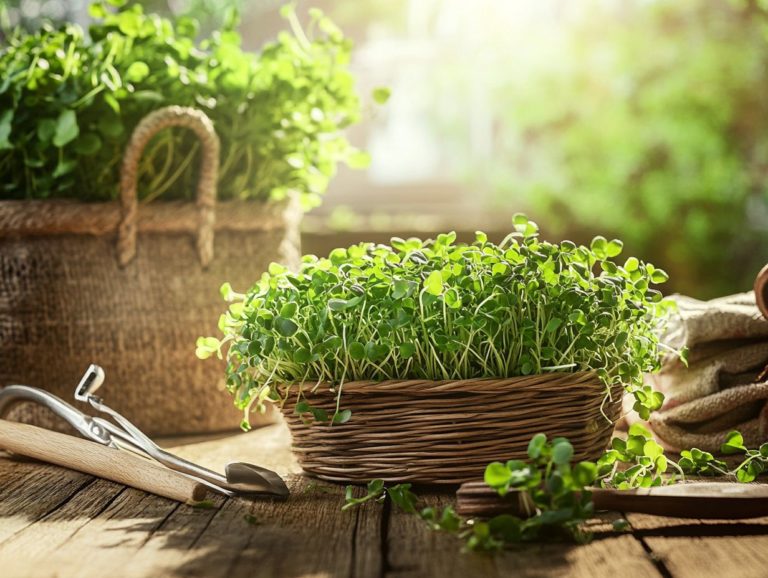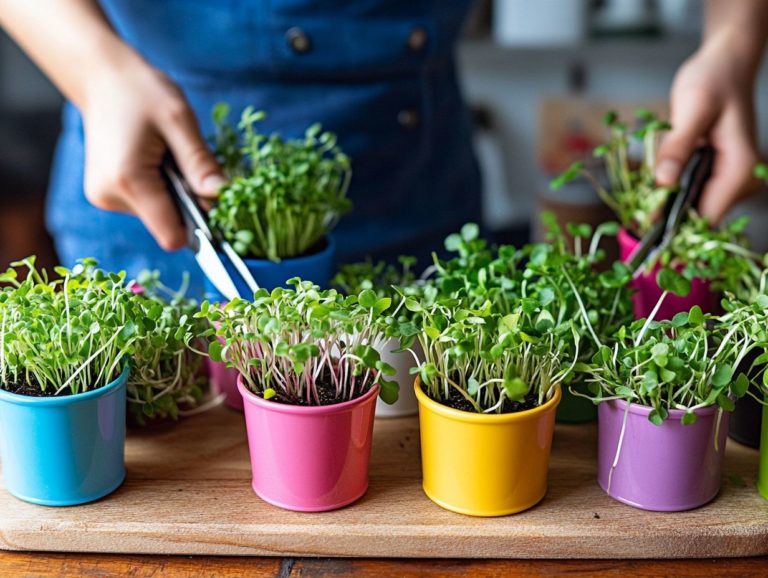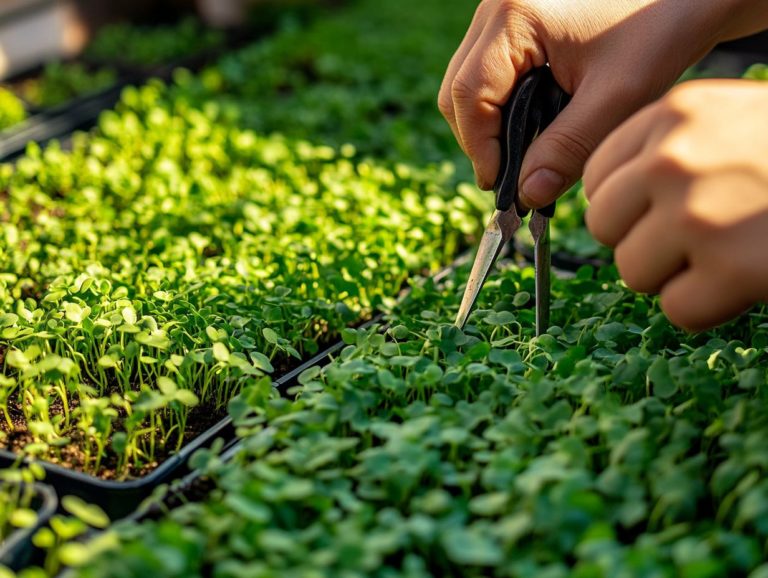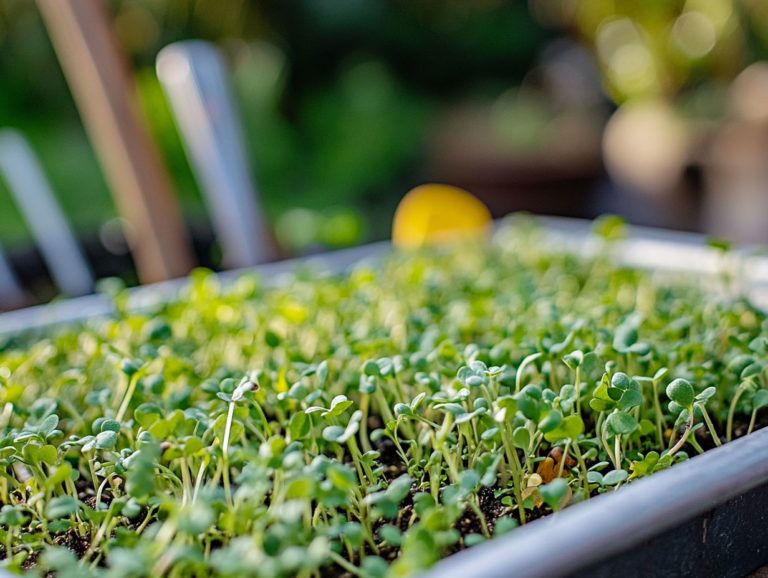The Impact of Humidity on Microgreen Storage
Humidity is essential for storing microgreens. It affects everything from their flavor to how long they last.
Grasping the mechanics of humidity and its measurement is crucial for growers and consumers alike.
This article explores the relationship between humidity levels and microgreens. It presents insights on the best storage conditions, the impact of humidity on freshness, and practical strategies for maintaining an ideal environment.
Whether you re a seasoned grower or just beginning your journey, this guide equips you with the knowledge to elevate your microgreen experience.
Contents
- Key Takeaways:
- Understanding Humidity Levels
- Effects of Humidity on Microgreens
- Optimal Humidity for Microgreen Storage
- Humidity Control Methods
- Other Factors Affecting Microgreen Storage
- Frequently Asked Questions
- What is the impact of humidity on microgreen storage and how does it relate to the preservation of their nutritional value?
- How does high humidity affect microgreen storage?
- Can low humidity impact the storage of microgreens?
- What is the ideal humidity level for storing microgreens and maintaining their freshness?
- How can I control humidity for better microgreen storage and enhance their nutritional value?
- Are there any other factors besides humidity that can impact microgreen storage and their overall freshness?
Key Takeaways:
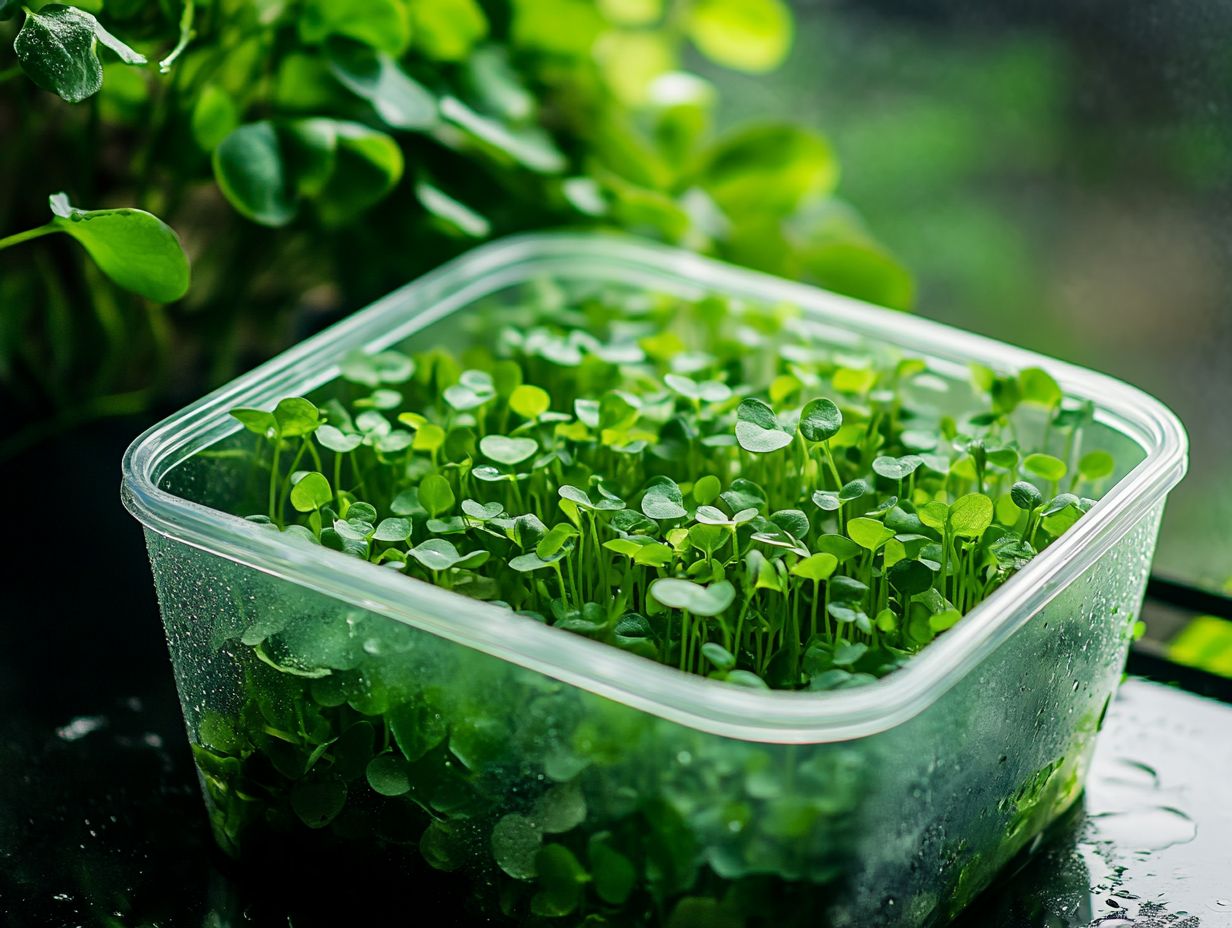
- High humidity levels can greatly affect the storage and shelf life of microgreens. This can lead to wilting and mold growth. Proper management of moisture levels is key for maintaining freshness.
- For optimal storage, microgreens require a humidity range of 95-100% for sprouts and 85-90% for leafy greens.
- To maintain ideal humidity levels, use tools like hygrometers (which measure air moisture) and techniques like misting and covering with breathable materials.
Understanding Humidity Levels
Understanding humidity levels is essential for the thriving growth and preservation of microgreens, especially in indoor gardening settings. Here, moisture, temperature, and air circulation create optimal conditions.
Effectively managing humidity enhances germination rates and extends the shelf life and freshness of your microgreens. This approach ensures their nutritional value remains at its peak from harvest to storage, especially when considering the impact of water quality on microgreens, making it ideal for sustainable agriculture.
What is Humidity and How is it Measured?
Humidity represents the amount of moisture in the air. You typically use a hygrometer to measure it, which is essential for understanding the growing conditions for your plants, especially microgreens.
Microgreens flourish best within specific humidity levels. These can be broken down into absolute and relative humidity. Absolute humidity tells you the total moisture content in the air, while relative humidity reveals how much moisture is present compared to the maximum the air can hold at a given temperature. For optimal growth and storage, it’s crucial to understand microgreen post-harvest care.
These measurements are vital for indoor gardening, where temperature control significantly impacts moisture levels. Maintaining the right humidity encourages healthy germination and wards off diseases caused by excess moisture.
Understanding these dynamics allows you to create an optimal environment for your home microgreens. This helps ensure your plants experience vigorous growth and yield high-quality results.
Effects of Humidity on Microgreens
Humidity levels play a crucial role in determining the freshness and shelf life of microgreens. By managing these levels, you can influence their overall health, vigor, and nutritional value.
Maintaining the right humidity controls moisture absorption and prevents condensation, which can lead to spoilage. Attention to this detail ensures your microgreens remain vibrant and nutritious for as long as possible.
How Humidity Affects Storage and Shelf Life
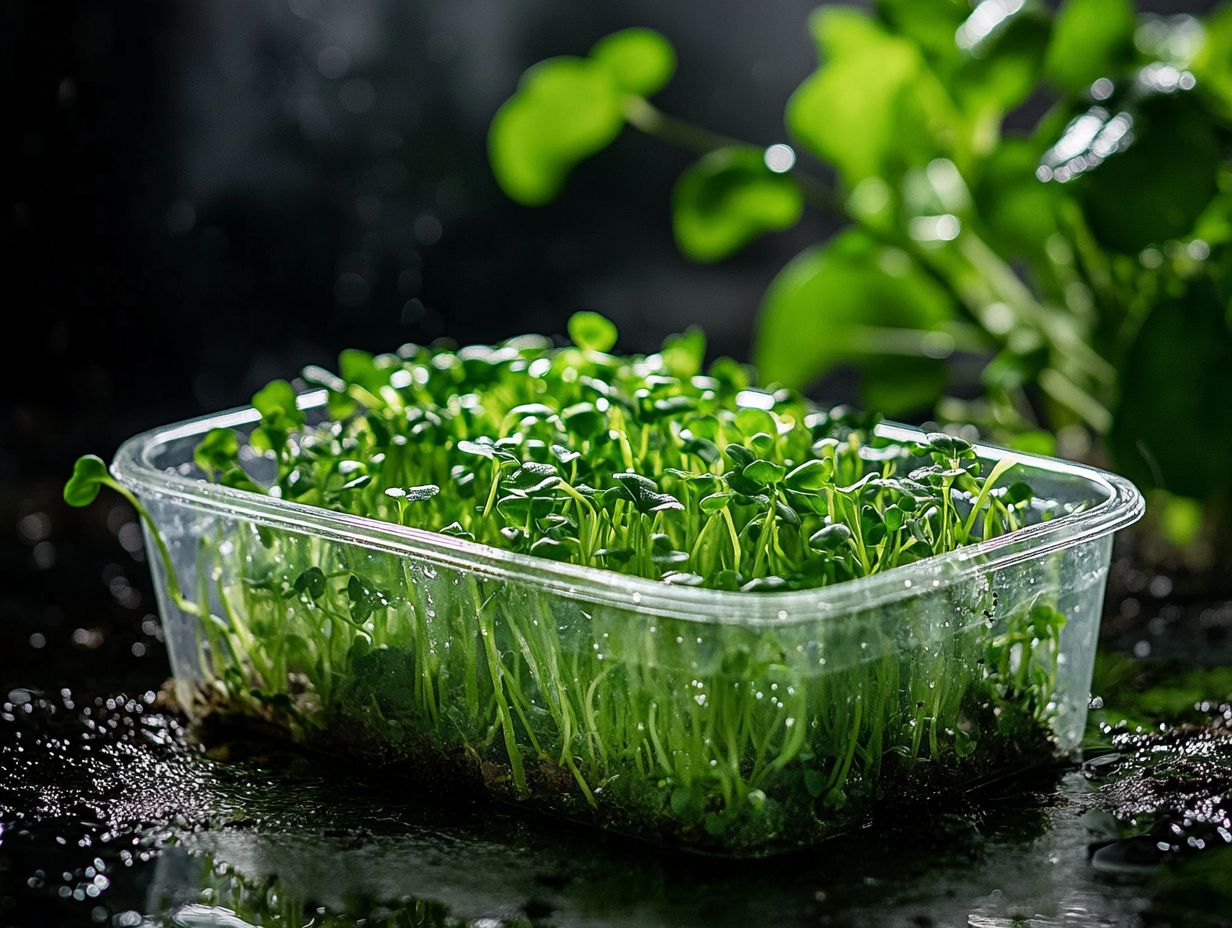
The level of humidity during the storage of microgreens is crucial for their shelf life. Excessive humidity can invite mold growth, while insufficient humidity may lead to dehydration, both of which detrimentally affect the overall quality of microgreen varieties.
Get excited about mastering the delicate balance of moisture to keep your microgreens fresh! Ideally, store microgreens in an environment where humidity levels hover around 50-70%.
Using vented containers can be a game-changer in regulating moisture levels. This allows for proper air circulation that helps prevent mold formation and wilting.
You might also consider using moisture-retaining materials like paper towels to strike the right balance. This ensures your vibrant greens remain crisp and flavorful during their time in storage.
Implement these best practices today to significantly enhance the overall storage conditions for your microgreens!
Optimal Humidity for Microgreen Storage
The ideal humidity level for storing microgreens depends on the specific variety. Typically, it hovers between 40-60%. This range is essential for preserving freshness and preventing spoilage.
Recommended Range for Different Types of Microgreens
Different types of microgreens flourish within specific humidity ranges. For instance, radish microgreens thrive in higher humidity levels around 60%. In contrast, sunflower shoots prefer slightly lower humidity, typically around 50%, to keep their texture crisp.
Grasping these nuances is essential for anyone eager to cultivate a vibrant microgreen garden. While radish microgreens add a spicy kick and demand more moisture, varieties like basil favor humidity levels that keep their leaves lush without becoming overly damp, usually around 40-50%.
This balance enhances flavor. It also prolongs shelf life. To maintain optimal moisture retention, consider employing humidity covers or misting techniques while ensuring proper air circulation.
By closely monitoring humidity, you can significantly elevate the freshness and vitality of your microgreens, transforming them into a delightful addition to any meal.
Humidity Control Methods
Implementing effective humidity control methods is crucial for preserving the quality and freshness of your microgreens. Utilize tools and techniques such as dehumidifiers, humidity trays, and appropriate storage containers to expertly manage moisture levels.
With the right approach, including gentle handling and proper exposure to light, you ll ensure that your microgreens thrive and maintain their vibrant characteristics.
Tools and Techniques for Maintaining Ideal Humidity
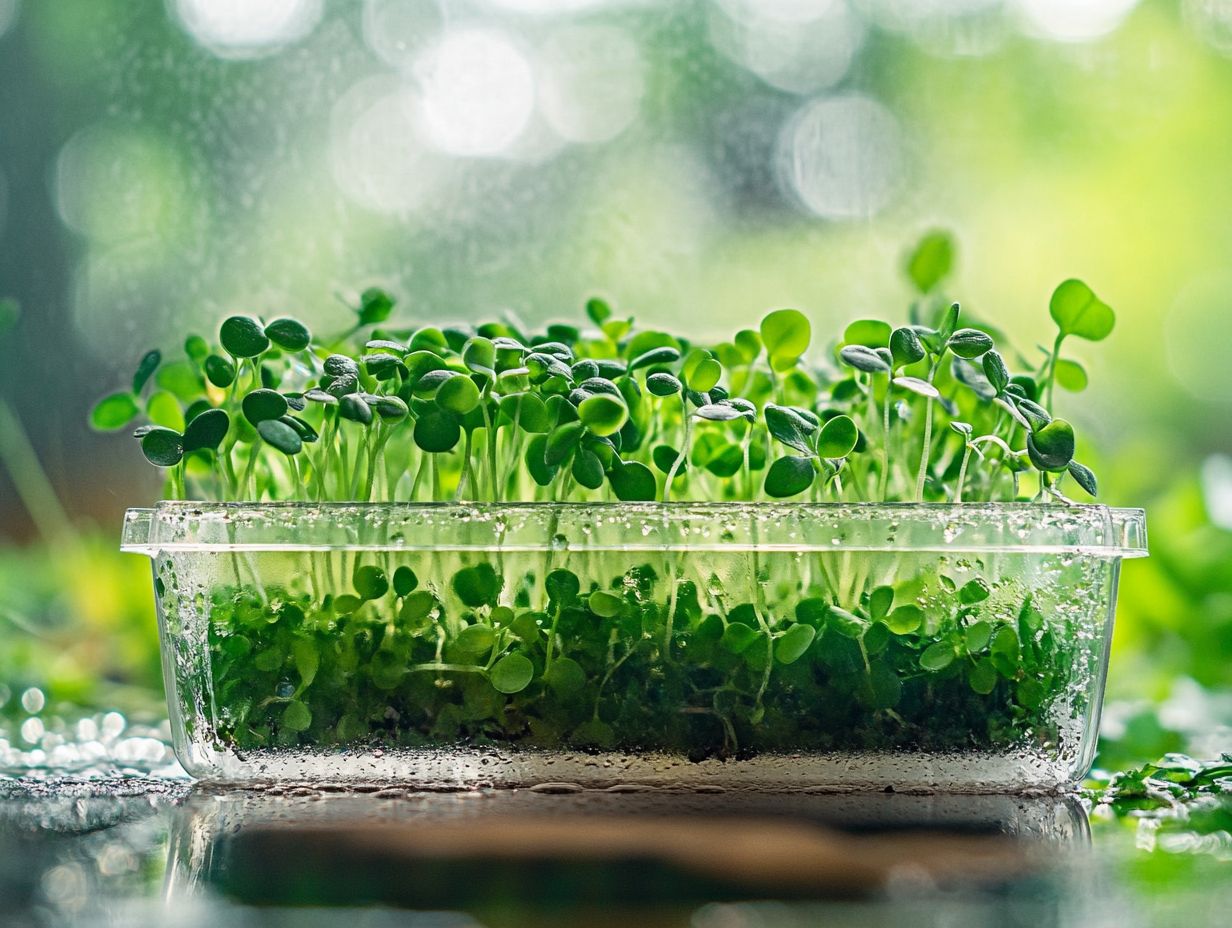
Discover powerful tools and techniques to maintain ideal humidity for your microgreens! Use Lock & Lock containers for airtight storage, hygrometers to monitor moisture levels, and humidity trays to enhance moisture retention.
Lock & Lock containers create an airtight environment that significantly reduces moisture loss. This ensures your delicate seedlings stay hydrated without the risk of drowning. Hygrometers provide real-time feedback on humidity levels, guiding you in fine-tuning your watering schedules to avoid the pitfalls of over or under-watering.
Humidity trays, filled with water and positioned beneath your seed trays, raise the ambient moisture in your growing area. This is especially helpful during dry seasons or in low-humidity environments. To maximize their effectiveness, regularly check and adjust the water levels in the trays. Mist early in the day to allow for adequate evaporation at night while retaining just enough moisture for vibrant, healthy growth.
Other Factors Affecting Microgreen Storage
Beyond humidity, several other factors play a crucial role in the storage conditions of microgreens. Consider temperature, air circulation, and light exposure, as they all significantly influence shelf life and overall freshness.
Temperature, Air Circulation, and Light Exposure
Temperature, air circulation, and light exposure play critical roles in the storage conditions of your microgreens. Aim for an optimal temperature range of 4 C to 10 C to prevent spoilage.
Maintaining this temperature is crucial. Even minor fluctuations can lead to rapid deterioration in quality, affecting both taste and nutritional value. Proper air circulation helps reduce moisture buildup, a common culprit behind mold growth and wilting. To understand the shelf life of microgreens, use fans or ventilated containers to ensure that fresh air consistently circulates around your microgreens.
Limiting light exposure during storage can also help preserve their vibrancy and flavor. Excessive light can stimulate unwanted growth that doesn’t serve your microgreens well after harvest. Additionally, understanding the role of temperature in microgreen storage is crucial. By adhering to these guidelines, you can significantly enhance the shelf life and flavor profile of your microgreens, ensuring they remain at their best for as long as possible.
Frequently Asked Questions
What is the impact of humidity on microgreen storage and how does it relate to the preservation of their nutritional value?
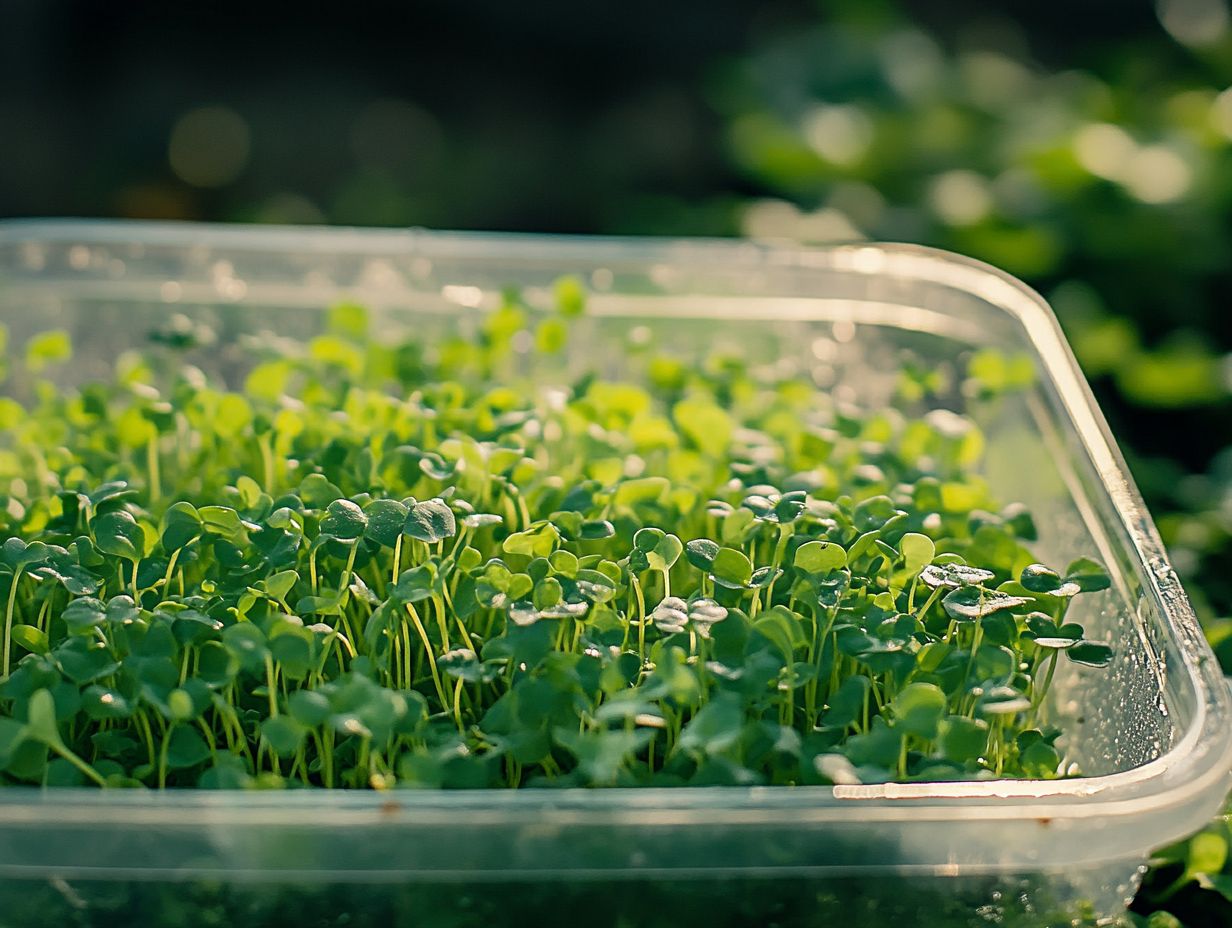
Humidity greatly affects the quality and shelf life of microgreens. Too much humidity causes mold and spoilage, while too little leads to wilting and loss of freshness.
How does high humidity affect microgreen storage?
High humidity creates a moist environment that encourages mold. This spoils microgreens quickly, making them unsafe to eat, and can lead to a slimy texture and bad odor.
Can low humidity impact the storage of microgreens?
Yes, low humidity causes microgreens to wilt and lose their freshness. This results in decreased flavor and texture, making them less enjoyable to eat.
What is the ideal humidity level for storing microgreens and maintaining their freshness?
The ideal humidity level is between 85-90%. This keeps microgreens fresh without creating mold-friendly conditions.
How can I control humidity for better microgreen storage and enhance their nutritional value?
Use a dehumidifier in the storage area to lower moisture levels and prevent mold. Storing microgreens in airtight containers also helps manage humidity.
Are there any other factors besides humidity that can impact microgreen storage and their overall freshness?
Yes, temperature and air circulation are crucial too. Store microgreens in a cool, well-ventilated area to maintain their freshness and prevent spoilage.

